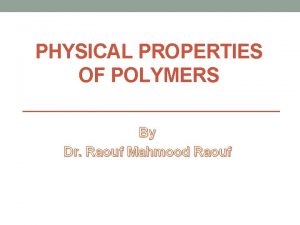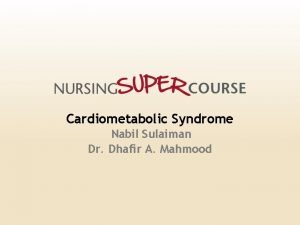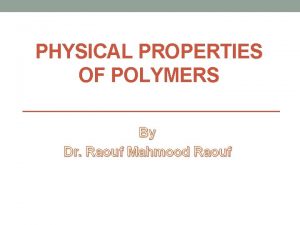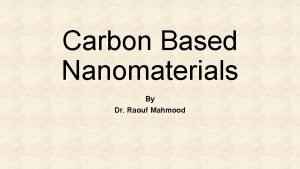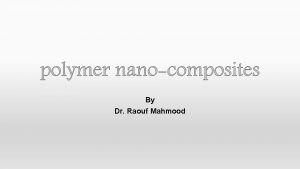DR RAOUF MAHMOOD Mechanical Properties Of Polymers It














- Slides: 14

DR. RAOUF MAHMOOD

Mechanical Properties Of Polymers It is of great importance to be familiar with some basic mechanical properties of the material before its application in any field, such as how much it can be stretched, how much it can be bent, how hard or soft it is, how it behaves on the application of repeated load and so on.

Mechanical Properties Of Polymers a. Strength: In simple words, the strength is the stress required to break the sample. There are several types of the strength, namely tensile (stretching of the polymer), compressional (compressing the polymer), flexural (bending of the polymer), torsional (twisting of the polymer), impact (hammering) and so on. The polymers follow the following order of increasing strength: linear < branched < cross-linked < network

Mechanical Properties Of Polymers Factors Affecting the Strength of Polymers: 1. Molecular Weight: The tensile strength of the polymer rises with increase in molecular weight and reaches the saturation level at some value of the molecular weight (Fig. 1). The tensile strength is related to molecular weight by the following equation: �� ∞ is the tensile strength of the polymer with molecular weight of infinity. A is some constant, and M is the molecular weight.

Mechanical Properties Of Polymers At lower molecular weight, the polymer chains are loosely bonded by weak van der Waals forces and the chains can move easily, responsible for low strength, although crystallinity is present. In case of large molecular weight polymer, the chains become large and hence are crosslinked, giving strength to the polymer. 2. Cross-linking: The cross-linking restricts the motion of the chains and increases the strength of the polymer.

Mechanical Properties Of Polymers 3. Crystallinity: The crystallinity of the polymer increases strength, because in the crystalline phase, the intermolecular bonding is more significant. Hence, the polymer deformation can result in the higher strength leading to oriented chains.

Mechanical Properties Of Polymers b. Percent Elongation to Break (Ultimate Elongation): It is the strain in the material on its breakage, as shown in (Fig. ). It measures the percentage change in the length of the material before fracture. It is a measure of ductility. Ceramics have very low (<1%), metals have moderate (1– 50%) and thermoplastic (>100%), thermosets (<5%) value of elongation to break.

Mechanical Properties Of Polymers c. Young’s Modulus (Modulus of Elasticity or Tensile Modulus): Young’s Modulus is the ratio of stress to the strain in the linearly elastic region (Fig. ). Elastic modulus is a measure of the stiffness of the material. d. Toughness: The toughness of a material is given by the area under a stress–strain curve (Fig. ).

Mechanical Properties Of Polymers The toughness measures the energy absorbed by the material before it breaks. A typical stress–strain curve is shown in (Fig. ), which compares the stress–strain behavior of different types of materials. The rigid materials possess high Young’s modulus (such as brittle polymers), and ductile polymers also possess similar elastic modulus, but with higher fracture toughness. However, elastomers Have low values of Young’s modulus and are rubbery in nature.

Mechanical Properties Of Polymers The yield strength of the plastic polymer is the corresponding stress where the elastic region (linear portion of the curve) ends (Fig. A). The tensile strength is the stress corresponding to the fracture of the polymer. The tensile strength may be higher or lower than the yield strength (Fig. A). The mechanical properties of the polymer are strongly affected by the temperature. A typical plot of stress versus strain is shown in (Fig. b). From the plot, it is clear that with increase in the temperature, the elastic modulus and tensile strength are decreased, but the ductility is enhanced.

Mechanical Properties Of Polymers e. Viscoelasticity: There are two types of deformations: elastic and viscous. Consider the constant stress level applied to a material as shown in the Fig. A. In the elastic deformation (Fig. B), the strain is generated at the moment the constant load (or stress) is applied, and this strain is maintained until the stress is not released. On removal of the stress, the material recovers its original dimensions completely, that is the deformation is reversible (Fig. B), that is: where E is the elastic modulus, �� is applied stress, and �� is the strain developed.

Mechanical Properties Of Polymers However, in viscous deformation (Fig. C), the strain generated is not instantaneous and it is time dependent. The strain keeps on increasing with time on application of the constant load, that is, the recovery process is delayed. When the load is removed, the material does not return to its original dimensions completely, that is, this deformation is irreversible (Fig. C). where

Mechanical Properties Of Polymers Usually, polymers show a combined behavior of elastic and plastic deformation (Fig. D) depending on the temperature and strain rate. At low temperature and high strain rate, elastic behavior is observed, and at high temperature but low strain rate, the viscous behavior is observed. The combined behavior of viscosity and elasticity is observed at intermediate temperature and strain rate values. This behavior is termed as viscoelasticity, and the polymer is termed as viscoelastic.

References 1. A. A. Askadski, “Physical Properties of Polymers Prediction and Control”, G & B publishers, Moskow, 1996. 2. Robert O. E. , “polymer science and technology, CRC Press, USA, 2000. 3. Sperling L. H. , “Introduction to physical polymer science”, John Wiley & Sons, Inc. USA, 4 th Ed. 1932.



